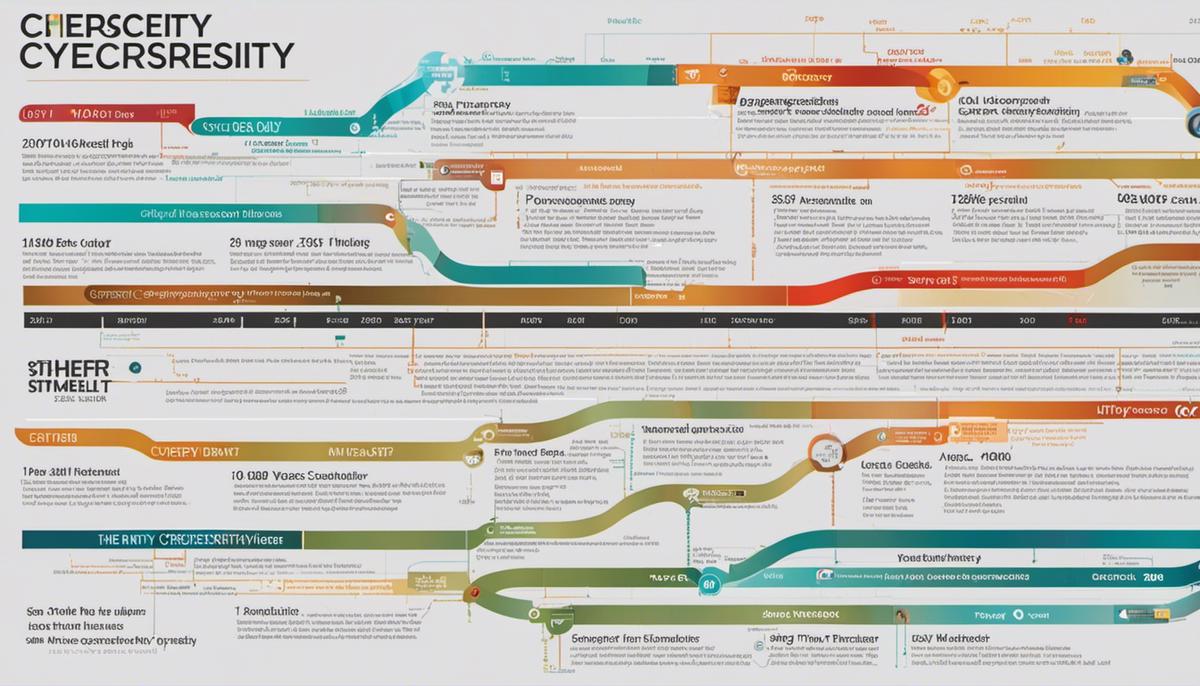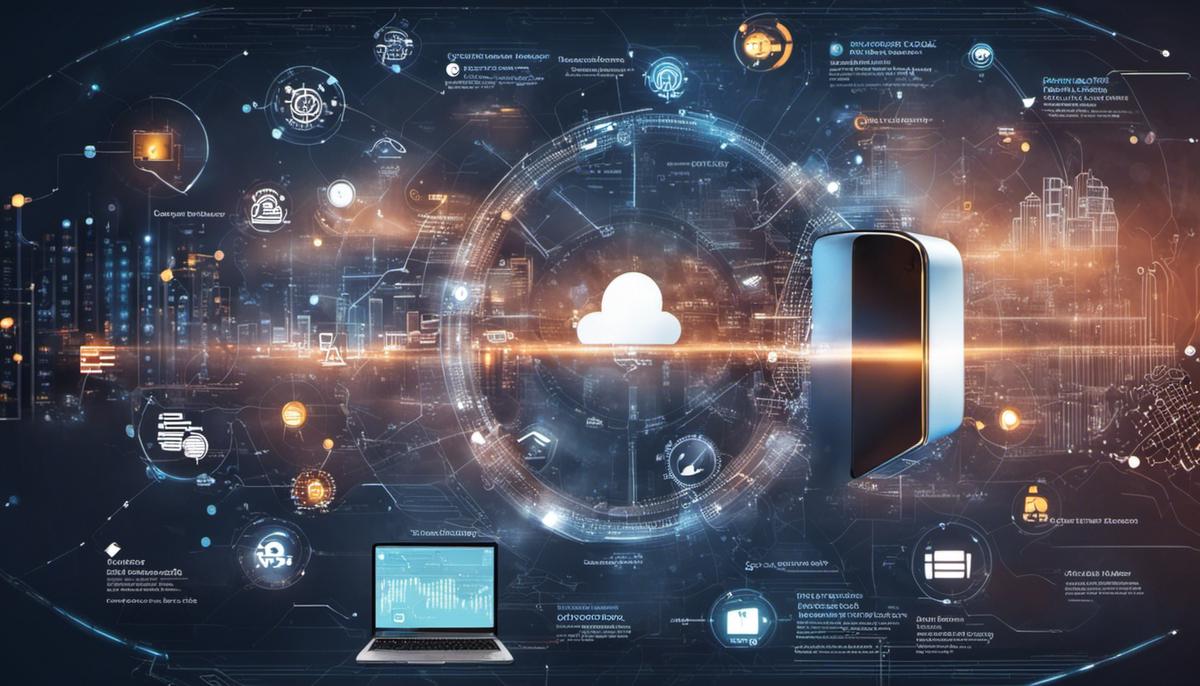As technology advances, cybersecurity has become an essential part of our daily lives. This text aims to provide a comprehensive understanding of cybersecurity history, principles, and policies to prepare us against sophisticated cyber threats.
The Evolution and Importance of Cybersecurity
The extraordinary evolution that information technology has experienced during the last four decades is undeniably impressive. However, the developments, while facilitating our lives in countless ways, also introduced a myriad of challenges – primarily, the compromise of privacy, data, and identity. Consequently, cybersecurity emerged as the paramount shield to these digital vulnerabilities. A comprehensive understanding of the history and evolution of cybersecurity is essential not solely for academics and professionals in this field but for anyone interacting with technology today.
In the dawn of the digital age during the late ’70s and early ’80s, the cybersecurity threats were relatively unsophisticated, with the emergence of the first computer virus, Elk Cloner. Although harmless by today’s standards, it marked the inception of a long race between security and threat – a race that is still fervently ongoing. By the ’90s, as the World Wide Web took its first steps and technology started to permeate every aspect of our lives, the threats became more serious. The appearance of cyber viruses, such as the infamous ILOVEYOU bug, which caused around $10 billion in damages, evidenced the growing complexity and urgency of addressing cybersecurity issues.
It was not until the turn of the millennium, spurred by these security threats, that cybersecurity started evolving into a distinctive discipline. Regulatory measures began to take shape, with the USA passing the first significant federal legislation in 2002, the Homeland Security Act. These legislative endeavors provided the much-needed impetus for the development of advanced cybersecurity frameworks, tools, and methodologies.
Over the past decade, the threats have been intensifying with jaw-dropping speed and sophistication, especially with the advent of technologies like cloud computing and the Internet of Things (IoT). The cybersecurity landscape today is populated by terms such as ransomware, phishing, and crypto-jacking – terms that are unfortunately too familiar to most of us. In the battle against these threats, cybersecurity has been rapidly advancing and mastering new frontiers like Artificial Intelligence and Machine Learning.
Grasping the history and evolution of cybersecurity is fundamental for multiple reasons. Firstly, it underlines the fact that cybersecurity threats are not static but evolve in tandem with technology. We can only counter these threats if we continuously learn, adapt, and innovate, which is precisely the ethos of cybersecurity as a field. Secondly, the past can be a rich repository of lessons and strategies that might inform present decisions and future directions. It is essential to remember methods that have been successful in the past and those that have failed.
Moreover, understanding the evolution of cybersecurity highlights how closely it has been intertwined with the development of technology and digital society, which underscores its relevance and significance in today’s world. Cybersecurity is not a peripheral issue but very much central to our digital existence, from protecting our most personal data and national security to influencing global politics and economics.
Finally, comprehending the history of cybersecurity offers valuable insights into emerging trends and potential future challenges. It was the omission of security considerations in the design of early internet protocols that led to many cybersecurity issues today. This key lesson illuminates the importance of incorporating robust security mechanisms in the design stage of any new technology if we aim to mitigate future security threats.
In conclusion, understanding the history and evolution of cybersecurity is fundamental to addressing the challenges we face in the digital age. It offers a rich perspective; teaching us the lessons of the past, making sense of the present, and preparing for the future – furthering or vision for a safer and more secure digital world.

Fundamental Concepts of Cybersecurity
With the ground covering essential historical and contemporary aspects of cybersecurity, it is vital to delineate the foundational principles and concepts that underpin this dynamic discipline. Grasping these principles will not only guide sound strategic thinking and tactics but also adapt and respond effectively to the ever-changing cyber threat landscape.
At its core, cybersecurity is guided by three fundamental principles known as the CIA triad – Confidentiality, Integrity, and Availability. Confidentiality pertains to preserving restrictions on information access and disclosure, thus ensuring privacy. Integrity involves safeguarding the accuracy and completeness of data by thwarting unauthorized alterations. Availability assures that authorized parties have reliable access to the data sets and computing resources when needed.
Underpinning the workings of cybersecurity is the concept of defense in depth, also known as layered defense. This approach uses a series of defensive mechanisms arrayed at diverse layers such as physical, network, host, application, and data. If one layer is breached, an attacker still has multiple layers to defeat before achieving their objective.
Another fundamental concept in cybersecurity involves the principle of least privilege (POLP). This principle gives a user or program only those privileges necessary to perform its intended function, thereby mitigating the potential damage from errors or malicious activities.
Moreover, critical to cybersecurity is the notion of risk management. Recognizing that it is impossible to ensure absolute security, risk management involves the process of identifying, assessing, and prioritizing the mitigation of risks. This approach enables the strategic allocation of resources to address the most critical risks first.
Understanding human behavior and culture plays an indispensable role in cybersecurity. Social engineering, the psychological manipulations of persuasion and influence over people to divulge confidential information, reminds us that the human element often poses significant security risks. Cybersecurity, therefore, necessitates a deep understanding of human psychology, organizational culture, and global societal trends.
Furthermore, maintaining situational awareness is fundamental to effective cybersecurity. This concept involves understanding and continually monitoring an organization’s digital assets and threat landscape to identify vulnerabilities and protect against potential threats.
Finally, the principle of iterative improvement, rooted in the belief that cybersecurity is not a one-time initiative but an ongoing process, holds significant importance. It necessitates continual learning, monitoring, adaptation, and upgrading of security measures to combat the evolving cybersecurity threats.
In conclusion, understanding these principles and concepts provides a robust foundation for the broader field of cybersecurity. Through the interplay of technical, human, and management elements, cybersecurity emerges less as a collection of separate tactics and more as a holistic, interdisciplinary approach necessary to thrive in a world increasingly shaped by digital technology.

Understanding Cybersecurity Threats
In the constant struggle to safeguard cyberspace, understanding the types of threats that exist is paramount. These threats can be broadly categorized into three segments, namely, Attacks on Confidentiality, Attacks on Integrity, and Attacks on Availability. Each one represents a potential violation of the CIA triad, which forms the core principles of cybersecurity: Confidentiality, Integrity, and Availability. An attack on confidentiality, for instance, might involve an unauthorized party gaining access to classified information, undermining the principle that data should only be accessible to those with designated privileges.
Moving forward, a crucial shift has occurred in the evolution of cybersecurity threats, prompting a parallel evolution in defense strategies. This shift has mainly emerged from the recognition that a purely technical, “hard-shell” approach focusing on intrusion prevention is insufficient in today’s complex threat landscape. An emerging strategy known as Defense in Depth adds multiple layers of protection to provide a more comprehensive security apparatus.
The Defense in Depth strategy entails deploying several layers of security controls throughout an information system. They could be referred to as the “moats and drawbridges” around the digital castle. Each layer has its unique function and when combined, they form a formidable line of defense against cyber threats. The ultimate goal is to deter, prevent, detect, and correct security breaches at various levels, making it prohibitively difficult for attackers to penetrate the system.
Another fundamental concept is the Principle of Least Privilege (POLP). POLP is a computer security principle in which a user is given the minimum levels of access necessary to complete job functions. By limiting the level of access employees have, companies can drastically reduce the likelihood of an accidental breach.
Incorporating human behavioral aspects into cybersecurity poses a new direction in battling evolving cyber threats. A significant portion of successful threats owes their success to the exploitation of human behavior. Cybersecurity culture seeks to address this by promoting practices and habits that individuals and organizations can adopt to enhance cybersecurity.
Risk management in cybersecurity engages in identifying, evaluating, and implementing measures to reduce risk to an acceptable level. Risk management strategies have evolved from simple countermeasures to more advanced methods where organizations assess their unique risk appetite realistically and set up appropriate measures accordingly.
As threats continue to transform, Situational Awareness becomes more critical in cybersecurity. This concept pertains to the ability to identify, process, and comprehend the critical elements of information about potential or current threats. It is an iterative process that involves continuous threat monitoring, data correlation, and analysis to empower proactive defense mechanisms.
The concept of Iterative Improvement emphasizes a cyclical approach to enhancing cybersecurity. In practice, this means that systems are continually monitored, vulnerabilities identified, and improvements made to bolster defenses. Just as cybersecurity threats evolve, so too must the countermeasures.
In essence, understanding these evolving threats and applying robust strategies such as Defense in Depth, POLP, integrating human behavior, risk management approaches, and ensuring situational awareness contribute to a holistic cybersecurity approach. The challenge is ever-evolving, and cybersecurity measures must reflect this dynamic reality. It paves the way for an iterative process of constant adaptation and improvement where learning is integral to resilience. As threats evolve and transform, the cybersecurity field continues to develop at the cutting edge of technology to counter them, driven by a commitment to safeguarding the digital realm in its entirety.

Cybersecurity Policies and Procedures
While forming a robust cybersecurity environment seems a predominantly technical task, it gets intriguing when one resurfaces the realization that the space it seeks to protect is essentially human. It’s no wonder that policies and procedures play an inextricable role in shaping such an environment. Closely tied to the diverse facets of organizational culture, they articulate clear expectations for behavior, decision-making, and communication protocols, reinforcing the boundaries that demarcate acceptable actions.
The incorporation of human behavior and culture tests the applicability of Strapmann’s Law, rooted in economics, which states that complex systems perform better when their individual components have simple rules to follow. In the realm of cybersecurity, it underlines that effective policies are the ones that are understandable, implementable, and directly relevant to the user’s tasks.
Rule-based cybersecurity management, often structured around the Principle of Least Privilege (POLP), does not merely prescribe restrictive dos and don’ts. Successful application of POLP involves continual risk assessments based on employee roles, the technologies they use, and the databases they access. It involves auditing and reviewing permissions regularly and revoking access once assignments are fulfilled. It involves indeed a delicate balancing act of enabling data accessibility while curtailing potential breaches.
Procedures that impart and bolster ‘situational awareness’ are immensely beneficial. Technologies offering real-time tracking, detecting, and alerting against potential threats play a crucial part in fostering this awareness. Yet, beyond technology, situational awareness calls for fostering a culture of alertness and vigilance among the personnel. It’s quintessential to stay a step ahead of potential threats, and such a pre-emptive approach is the cornerstone of effective cybersecurity.
Unleashing the full potential of ‘defense in depth’ – a layered approach to security – also demands precision-cut policies and procedures. This strategy, designed to defend a system against any particular attack using several independent methods, is rooted in military strategy, where it’s termed as “defense in depth”. Policies and procedures should clearly outline the layered defenses and enumerate the roles tied to each.
In a world where cyber threats are becoming increasingly sophisticated, embodying iterative improvements in policies and procedures is non-negotiable. An organization must continuously evaluate, reassess, and innovate its practices, shaping them in congruence with the multifaceted dynamics of cybersecurity threats.
A disciplined and serious approach to cybersecurity policies and procedures does not only erect a technical fortress but also weaves a resilient, vigilant, and responsive human firewall. Conclusively, fostering a secure cyber environment is a journey of continuous improvement, powerful collaborations, and thoughtful insights that transcend beyond the realms of technology’s ingenuity.

Emerging Trends and Future of Cybersecurity
As we peer into the future of cybersecurity, two predominantly emerging trends cast long shadows on the horizon – the pivotal role of quantum technology and an escalation of cyber warfare.
Quantum technology is advancing at a rapid pace. Quantifying its implications for cybersecurity is a realm of ongoing research. While quantum computers hold the promise of defeating existing cryptographic security methods due to their superior computational power, they also pave the road to uncrackable quantum encryption. Defending against quantum attacks necessitates the development of post-quantum cryptography. This spells a transformative change for the cybersecurity landscape, as it calls for a complete overhaul and upgrading of existing security systems to quantum-resistant algorithms – a costly but necessary endeavor.
Equally noteworthy is the escalating threat of cyber warfare. Country-sponsored cyber-attacks are on the rise, highlighting a shift in strategies that nations adopt to assert their dominance, disrupt rivals, and protect national interests. Cyber warfare extends beyond simply damaging an adversary’s digital infrastructure. It involves the use of cyber tools to wage psychological warfare and propagate disinformation, a fact that adds a new layer of complexity to the cybersecurity matrix. Hence, there is a pressing need for robust international norms and cooperative strategies to curb this growing menace.
Consider also the rising importance of biometric security mechanisms. More devices are leveraging facial recognition, fingerprints, and other biometric signatures as a security measure. However, storing and processing such sensitive data presents another opportunity for cybercriminals to exploit. Hence, securing biometric data while maintaining its accuracy raises a unique challenge for cybersecurity practitioners.
Lastly, the cyber-physical security of Internet of Things (IoT) devices and systems cannot be overlooked, given our growing dependence on them. The intersection between the physical and digital world results in vulnerabilities that can have significant real-world ramifications. As a result, future cybersecurity protocols must focus on securing assets that straddle the digital-physical divide.
In conclusion, the future landscape of cybersecurity is complex, composed of an interlocking set of challenges surrounding quantum technology, cyber warfare, biometric security, and cyber-physical security of IoT devices. The road ahead warrants consistent investment and research to navigate these challenges, develop effective countermeasures, and secure the digital universe. Most importantly, continuous education, staying abreast of the latest developments, and fostering a culture of security awareness are our best defenses and will shape the future of cybersecurity.

The fascinating journey of cybersecurity, synonymous with evolution in technology, provides significant revelations on the critical role it plays in our digital life. Its vast complexity, which covers various threats to equally diverse defense mechanisms, paints a picture not just of its past but also predicts its future trajectory. The increasingly sophisticated threat landscape demands a well-structured and dynamic approach to security policies and procedures. It enforces the need to continually evolve, be mindful of emerging innovations, and incorporate them to fortify the defenses. The engagements with recent advancements like Machine Learning, AI, and Quantum Cryptography further reinforce our responsibility to innovate and protect in this digitized world. Thus, understanding cybersecurity is not just reviewing a technical facet but learning about a crucial layer of our existence in a progressively digital society.
